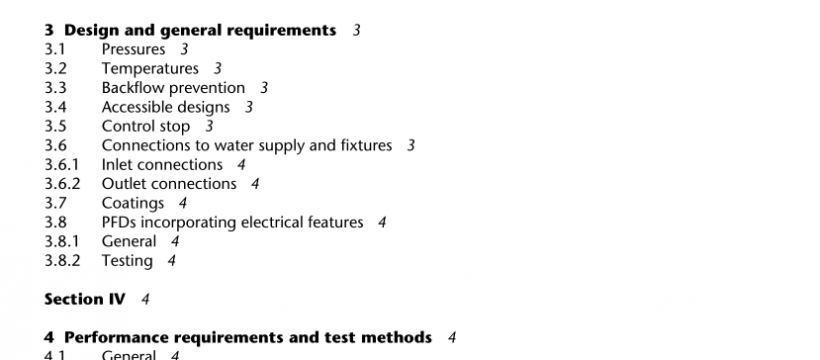ASME A112.1037:2015 pdf free download
ASME A112.1037:2015 pdf free download.Performance requirements for pressurized flushing devices for plumbing fixtures
4.8.2 Procedure
The life cycle test for integral control stops for PFDs shall be conducted as follows:
(a) Install the test specimen on a test stand with the PFD discharging to atmosphere.
(b) Position the integral control stop in the closed position.
(c) Pressurize the control stop to 860 ± 35 kPa (1 25 ± 5 psi).
(d) Check for leaks:
(e) Reduce the pressure 41 5 ± 20 kPa (60 ± 3 psi).
(f) Operate the control stop for 500 cycles, as follows:
(i) One complete cycle shall be operating the control stop from the fully closed position to at least 80% of the fully open position, without making contact with the end stops, and back to the fully closed position.
(ii) The rate of opening and closing the control stop should not exceed 250 cycles per hour to effectively simulate its manual operation.
(g) Upon completion of the 500 cycles of operation,
(i) close the control stop;
(ii) pressurize the control stop to 860 ± 35 kPa (1 25 ± 5 psi);
(iii) maintain the pressure for 5 min; and
(iv) check for leaks.
4.9.1 Purpose
The purpose of the hydrostatic pressure test for non-tank type PFDs is to determine if the PFD is capable of withstanding a hydrostatic test pressure of 3,450 kPa (500 psi).
4.9.2 Procedure
The hydrostatic pressure test for non-tank type PFDs shall be conducted as follows:
(a) Close the PFD.
(b) Pressurize the PFD to a hydrostatic pressure of 3,450 ± 35 kPa (500 ± 5 psi) through the inlet.Maintain the pressure for 1 min.
4.10.1 Purpose
The purpose of the hydrostatic pressure test for tank type PFDs is to determine if the PFD is capable of withstanding a hydrostatic test pressure of 3,450 kPa (500 psi) or two times the minimum relief valve opening pressure, but in no case less than 550 kPa (80 psi).
4.10.2 Procedure
The hydrostatic pressure test for tank type PFDs shall be conducted as follows:
(a) Remove or deactivate for PFDs that incorporate such devices.
(b) Increase the pressure at the inlet by increments of 7 kPa (1 psi) per second, from 0 kPa (0 psi) until the relief valve is discharging at a flow rate of at least 5 mL/min (0.1 7 oz/min).
(c) Record the pressure in Item (b) and name it as the minimum relief valve opening pressure.
(d) Block the outlet of the relief valve.
(e) Pressurize the PFD to a hydrostatic pressure of two times the minimum relief valve opening pressure,but not less than 550 kPa (80 psi).
(f) Maintain the pressure for 5 min.
(g) For PFDs without a relief valve, slowly increase the pressure to 3,450 ± 35 kPa (500 ± 5 psi).
(h) Maintain the pressure for 1 min.
ASME A112.1037:2015 pdf free download
